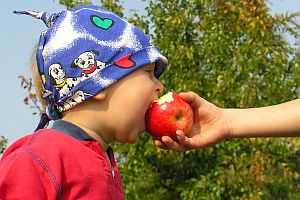Is It Really Possible to “Re-train” Your Taste Buds to Prefer Healthier Foods?

The modern American diet is laden with over-salted, over-sugared and over-processed foods. Sodas, fast food and pre-packaged feasts are all contributing to an epidemic of weight gain and poor health, including chronic cardiovascular and metabolic conditions (such as high blood pressure and diabetes) as well as chronic musculoskeletal problems (such as knee and low back pain).
Most of us recognize that eating a well-balanced, nutritious diet is necessary for maintaining optimal health and managing your weight. But the unfortunate truth is that most of us still crave a juicy cheeseburger or candy bar over a salad. In fact, unhealthy foods can actually be habit-forming for some people, making it difficult for them to make necessary changes.
The good news is that you really can learn to crave more healthful foods while curbing your desire to gobble up junk.
Try, try again.
Although the body does naturally seek out salty and sweet flavors, you didn’t exit the womb needing potato chips for survival. This was a food you tasted and decided you enjoyed. Some foods are an acquired taste—think coffee, tripe or caviar. Chances are you didn’t immediately love any of these foods the first time you tried them (and maybe you still don’t).
Most people need as many as 10 tastes of a single food item to get used to the flavor. This means you don’t have to eat 10 whole plates of Brussels sprouts, just taste a tiny forkful of someone else’s from time to time. With each bite, your taste buds will know what to expect and you will be less likely to react with pursed lips. And, yes, eventually you may even learn to enjoy it.
It takes time.
You can’t learn to play the piano in one evening, and you probably won’t learn to love a tofu stir-fry that fast either. Take comfort in the fact that you will eventually come to enjoy healthy foods such as fresh fruits and legumes.
In a 2014 study by Tufts University in Massachusetts, researchers scanned the brains of adults who were eating a diet high in protein and fiber, which is found largely in fruits and vegetables. The study found that after 6 months of healthful eating, the area of the brain often cited as the “reward center” became activated when participants viewed images of healthy foods. And that’s not all—their brains became less “turned on” by unhealthy foods such as chips or candy.
Get creative with your cooking.
No food is exciting to eat when it’s boiled plain or zapped in a microwave. Instead, try roasting, sautéing or grilling your vegetables and proteins (chicken, fish or even buffalo, for example). Longer, slower forms of cooking work to caramelize the foods. This draws out the food’s naturally occurring sugars and enhances the flavor.
Choosing the right seasonings can also dress up an otherwise bland course. Try a pinch of ancho chili powder or sriracha sauce if you’re looking for spice, or sprinkle on a little cinnamon or turmeric for some exotic flair.